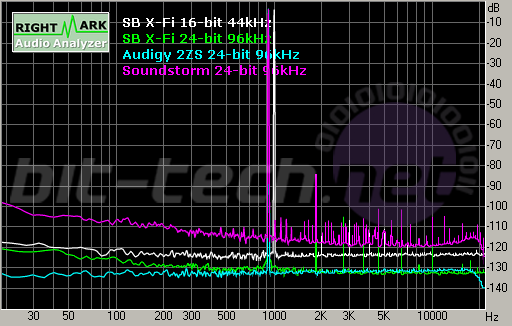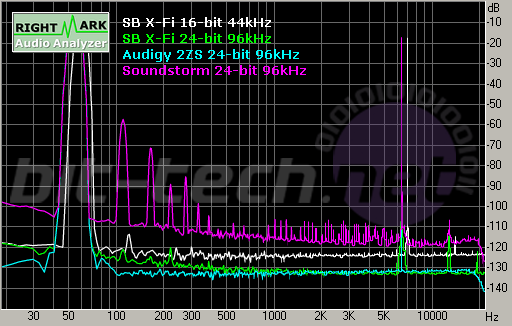
Test results
To see how the X-Fi measured up to its claimed specification, it was tested using
RightMark Audio Analyser 5.5 software. For comparison we have included test results from Creative’s previous generation card, the Audigy 2 ZS and NVIDIA’s integrated audio solution, the nForce Soundstorm, which was not only very popular, but produced some of the best on-board audio of all chipset-based sound. We included it to test the theory that on-board sound is "good enough" compared with a top add-in soundcard.
Looking at the summary table below, we see that both Creative cards fair much better than the Soundstorm in all of the tests, which really goes to show that the integrated solution is no match for either of the dedicated soundcards.
What is surprising is how close the X-Fi and Audigy 2 ZS are in the measurement tests and the Audigy besting the X-Fi in the total harmonic distortion test. (THD).
Summary

What follows are the results graphs from the tests. They pretty much speak for themselves. All the results where taken at 24-bit, 96kHz since this gives the best representation of each cards potential. The X-Fi results also include 16-bit, 44.1 kHz for comparison.
Frequency response

The human ear can hear frequencies from about 20Hz up to 20kHz. The frequency response graph plots how accurately the cards reproduce these frequencies. Looking at the graph, the flatter the trace, the better it is.
Noise level

This is the residual or background noise, such as "hiss" that the card generates. Sometimes referred to as the "noise floor". This is unwanted noise so the lower the trace, the quieter the card is when no sound is being played. The Creative cards are virtually silent, whereas the on-board NVIDIA SoundStorm is relatively noisy by comparison.
Dynamic range

Dynamic range is the difference in volume between the quietest and loudest sounds that the card can reproduce. Obviously the quietest sound is the noise floor shown above. Looking at the graph below we can see that the spike at 1000Hz (1kHz) represents the dynamic range.
THD + Noise (at -3 dB FS)

THD or Total Harmonic Distortion is the amount by which the card changes, or distorts the signal. It is expressed as a percentage of the original signal. Here, less if better. The graph does not actually represent the distortion but shows that the test was carried out at 1 kHz.
Intermodulation distortion

Intermodulation distortion occurs when two or more frequencies interact with or modulate each other. This can produce a "warbling" sound. An example of deliberate modulation distortion is the familier Dalek voice from Dr. Who. Ideally, the cards should reproduce the entire range of frequencies simultaneously without any interaction between them. The test uses two tones, a low of about 50Hz and a high around 6kHz and measures their interaction.
Stereo crosstalk

Crosstalk is how much "leakage" there is from one stereo channel into the other. This leakage spoils the stereo effect and hence the least amount of crosstalk is better. Once again, all the Creative cards perform well, and the SoundStorm just can't keep up.
Just for comparison here are Creative’s published X-Fi’s results compared to ours. The tests were conducted at 24-bit, 96 kHz. As you can see, there is not much between them.
Creative’s published results

Bit-tech’s test results.





















Want to comment? Please log in.